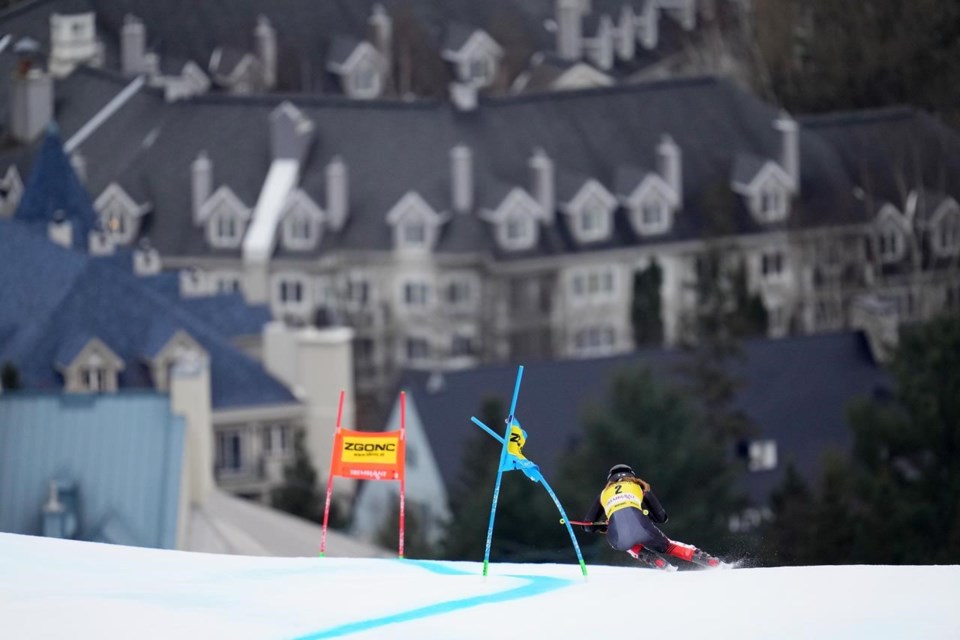MONT-TREMBLANT, Que. — Alpine Canada president and chief executive officer Thérèse Brisson gives Mont-Tremblant’s first World Cup event in 40 years a "10-on-10" rating — and hopes it’s here to stay.
Fans surrounded the finish line and filled the streets at the centre village this weekend, cheering for all 61 racers during two giant slalom races at the Laurentians ski resort.¬Ý
Over 15,000 total spectators attended the races on Saturday and Sunday, making it the second most-attended women’s World Cup event after Killington, Vt., according to Brisson.
"Who wouldn't be happy about this?” said Brisson from the hill Sunday. "Yeah, we'd love to make this a permanent venue for years and years to come."
Tremblant, which hosted its first alpine World Cup race in 1983, replaced the traditional downhills at Lake Louise, Alta., as the only women’s stop in Canada on the International Ski and Snowboard Federation (FIS) calendar this year.
By all accounts, the new location made a strong first impression.
"The athletes are thrilled, the coaches are super happy," said Brisson. "What they really appreciate is the fans understand ski racing, they're cheering every racer right down to the 61st racer. That's unique.
"They're thrilled by –°¿∂ ”∆µ able to take 10 steps to the lift, it's great for the athletes. So I think the FIS is pretty excited about the potential of this."
Alpine Canada announced two more giant slalom races are scheduled next year from Dec. 6-8. Although Tremblant also features on the FIS long-term calendar for the 2025-26 season, that won't be confirmed until next year.
Brisson said Canada’s strong women’s tech team, the committed ski racing fans in Eastern Canada and Alpine Canada’s relationship with the Tremblant resort were three big pillars in the governing body’s decision to host this event.
Valérie Grenier, a past World Cup giant slalom gold medallist and Canada’s top skier on the weekend, is from St. Isidore, Ont. but also calls Tremblant home.
"We have an amazing women's tech team and it was important for us to give women the spotlight that they deserve," said Brisson. "Quebec has been a powerhouse in developing those athletes.¬Ý
"The region has such a large and enthusiastic fan base, we have a highly engaged volunteer community, and for that reason, it made so much sense for us to bring a World Cup here in Quebec, in the East."
The athletes certainly took notice, including some all-time greats.
"The atmosphere, after we came from Killington, the loudest race we have in the World Cup, to come here and I would say we can hear (the crowd) from the start again," said World Cup wins record-holder Mikaela Shiffrin of the United States. "The enthusiasm is really wonderful."
"The ski racing community and Tremblant is definitely like a core strength in Canada," added Cassidy Gray of Panorama, B.C. "There's not a lot of places that can top this."
Canadian women’s team head coach Laurent Praz said having athletes compete in front of so many fans is essential to growing the sport in the country, which is why set-up at Tremblant made so much sense.
"Lake Louise was an awesome super G and downhill slope, that's for sure. But my feeling is that here, in this region … we can feel more the passion," he said last week. "Lake Louise no one was coming to watch the race at the end."
Additionally, the retirement of veteran Marie-Michèle Gagnon this year left Canada without an established downhill skier.
The FIS also removed a tentative men's downhill at Lake Louise from this season's calendar in July. But Brisson reiterated that Alpine Canada is dedicated to securing a men’s World Cup downhill location in Western Canada.
"Lake Louise has been an amazing venue for 30-40 years. What we're looking to do now is to build the environment for the next 20 years, and so (Tremblant) is certainly part of that," said Brisson.
"And we're committed to finding a solution for men's speed, which can only be in the West … It's really important for us to have a men's speed World Cup here in Canada as well."
Brisson believes there‚Äôs a lot still to improve in the coming years to make the event bigger and more inclusive.¬Ý
Expanding on programs that help young girls develop in ski racing, holding conferences, creating a festival environment and building more seating for fans are all part of the agenda.
This report by The Canadian Press was first published Dec. 4, 2023.
Daniel Rainbird, The Canadian Press



